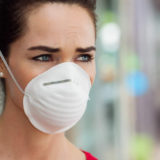Each year, in preparation of the inevitable flu epidemic, millions of Americans flock to medical offices and clinics to get the pharmaceutical industry’s best effort at formulating an effective vaccine for this season’s strain of the virus. Of course, even the manufacturers of the vaccine will tell you that it is not a guarantee against contracting the illness and many people, including me, cannot or choose not to get the vaccination. Whether you do or don’t get the shot, by choice or necessity, there are things you can and should do to lower your risk of contracting this inconvenient, uncomfortable and often serious malady.
Influenza A (the flu) is thought to be spread via two vectors: by inhaling droplets from the air after an infected person has coughed or sneezed nearby, or by touching a surface that has recently been touched by an infected person who has the living virus on them (i.e. the credit card stylus at the supermarket, doorknobs, telephones, etc.). And, since an infected person can begin spreading the germs before he or she starts having symptoms, containing the spread of the illness once an outbreak occurs is nearly impossible.
This leaves three alternatives for dealing with this nasty bug:
- Resign yourself to catching the flu and deal with it when and if it happens.
- Seal yourself in a sterile bubble from October to June.
- Take steps to avoid the flu or minimize its effects should you come in contact with the virus.
However, try following the three steps of flu prevention listed below and you may just get through the winter unscathed:
- Step 1: Keep Your Hands Clean. Unless someone sneezes right next to you and doesn’t cover up, there is a good chance that the bug to which you get exposed will get on your hands first. When the virus is on your hands it has a good chance of getting transmitted to your face where it can gain entry to your upper respiratory tract. Washing your hands frequently during the day with warm water and soap will remove the germs and protect you from exposure. It is also a good idea to have a small bottle of hand sanitizer gel in your pocket when you are away from home and unable to wash your hands. Making this small change a habit will go a long way to keeping you healthy this winter.
- Step 2: Keep Your Fingers Out of Your Mouth, Nose and Eyes. Enough said.
- Step 3: Keep Up Your Daily Intake of Vitamin D. Vitamin D3, the activated form that our body uses, is an essential nutrient for immune system function, bone mineralization and cell health. It is primarily produced in our bodies as a result of exposure to ultraviolet B radiation.
In the late 1970s, the noted British researcher, Dr. R. Edgar Hope-Simpson, theorized that the predominance of influenza occurrences in the winter months was due to an “unknown seasonal” factor that impaired human immunity in the winter. In 2005, Dr. John J. Cannell, a psychiatrist at Atascadero State Hospital in California noticed a correlation between Vitamin D3 supplementation and infection rates in patients during an outbreak of the flu in the hospital. He then began a study, enlisting the aid of other researchers, attempting to draw a conclusive connection between blood Vitamin D levels and patient resistance to Influenza A infection. They published their findings in 2006.
At about the same time, a group of UCLA scientists published a study in the respected journal, Nature, showing that a naturally occurring steroid hormone in our bodies was actually a potent antibiotic. It worked by increasing the body’s production of antimicrobial peptides, a protein that kills bacteria, fungi and viruses. Furthermore, this very same hormone prevents the immune system from flooding infected lung tissue with chemokines and cytokines, the inflammatory cells that cause the most dangerous complication of the flu – pneumonia.
I gave you this brief history to underscore the importance of what I am proposing in this article. Based on this research, and understanding the seasonal limitations of natural Vitamin D production in the human body, I am convinced that Vitamin D3 taken as a supplement during the months when solar exposure to our skin is limited, is a key component in supporting our natural ability to fight off infection from a year-round virus that seems most potent during these winter months. Therefore, it is my professional impression that daily Vitamin D3 supplementation during the flu season will significantly reduce your chances of contracting the illness and, should you develop symptoms, will help your immune system fight it off.
Here’s a list of maximum dosages by age, as recommended by the Institute of Medicine’s Food and Nutrition Board:
- Adults – 4,000 IU/day
- Ages 4 – 8 – 3,000 IU/day
- Ages 1 – 3 – 2,500 IU/day
- Ages 6 – 12 months – 1,500 IU/day
- Ages 0 – 6 months – 1,000 IU/day
Personally, I am comfortable in using dosages of 2,000 IU/day for my wife and me and 1,000 for my 7 year-old son. As I am not a licensed pediatrician, I will not recommend the use of this nutrient for anyone else’s child and advise you to seek the guidance of your pediatrician before beginning any supplementation program.
Another approach to getting more Vitamin D3 in the winter is to eat the foods listed below and include a well-designed multi-vitamin, which will contain 400 – 600 IUs per dose, into your daily regimen.
- Salmon and mackerel
- Mushrooms
- Tuna canned in water
- Sardines
- Milk, yogurt or cheese
- Beef or calf liver
- Egg yolks
Do these things and I feel confident that you will have a healthier winter season. And remember to keep well hydrated (with water) and use a good Vitamin C complex for added protection.




